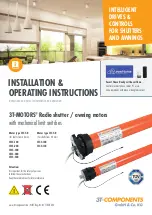
Single Cylinder Ringed Four Cycle Engine
M A G N U M X L 1 . 2 0 R F S
The Magnum XL 1.20RFS is a single cylinder, overhead valve four stroke
engine incorporating ringed piston technology for long life and a dual needle
carburetor for precise adjustments. A polished aluminum muffler is in-
cluded to keep the noise to a minimum without sacrificing power. The
engine was designed by expert engineers and built by master craftsmen
using only the highest quality materials and CNC machinery. These quali-
ties provide the long life and dependability you have come to expect from
an engine of this caliber.
INTRODUCTION
BECOMING FAMILIAR WITH THE MAGNUM
XL 1.20RFS
Before attempting to operate your new engine, please read through this
instruction sheet in it’s entirety. This will help you familiarize yourself
with the features and operation of your new engine. Use the photos below
to identify the major component parts of your new engine.
SPECIFICATIONS
Displacement.............................................19.6cc (1.22cu.in.)
Bore............................................................................30.4mm
Stroke..........................................................................27.5mm
Practical R.P.M.................................................2,000 - 11,000
Weight (w/Muffler)....................................................31.08oz.
Crankshaft Thread Size...............................................5/16-24
WARNING!
Magnum model engines will consistently give you dependable performance
and reliability and will be a source of satisfaction and pleasure if you fol-
low these instructions as to the engine’s proper and safe use. Do not let
pleasure turn into injury and/or tragedy! You alone are responsible for the
safe operation of your engine, so act sensibly and with care at all times.
This Magnum model engine is not a toy. It is a precision built machine
whose power is capable of causing serious injury to yourself and others if
abused, misused or if you fail to observe proper safety precautions while
using it.
N
Keep spectators, especially small children, at least 20 feet away from
the engine while it is running.
N
Mount the engine securely in the airplane or on a suitable engine test
stand to run the engine. Follow the mounting instructions in your kits
instruction manual or on the plans for individual mounting recommenda-
tions. Do not clamp the engine in a vise to test run it.
N
Use the recommended size propeller and follow the proper procedure
for mounting the propeller. Use the correct size wrench to tighten the
propeller nuts. Do not use pliers.
N
Inspect the spinner, propeller and propeller nuts on a regular basis,
looking for any signs of nicks, cracks or loosening.
N
To stop the engine, adjust the throttle linkage to completely close the
throttle barrel and therefore cut off the air supply. You can also pinch the
fuel line to stop the engine, but only if it is accessible. Do not throw
anything into the spinning propeller or attempt to use your hands to stop
the engine.
N
Stand behind the engine when it is running to make any adjustments
to the mixture controls. Do not reach over or around the propeller. Do not
lean towards the engine. Do not wear loose clothing or allow anything to
be drawn into the spinning propeller when the engine is running.
N
If you need to carry your model while the engine is running, be con-
scious of the spinning propeller. Keep the airplane pointed away from you
and others.
N
Do not use tight fitting cowls or oversized spinners as these can im-
pede airflow over the engine and result in overheating and damage to the
engine.
INSTALLATION
q
Engine Orientation
The Magnum XL 1.20RFS can be orientated in any position on the fire-
wall. Keep in mind that when the engine is mounted inverted, carburetor
adjustments will need to made differently and the fuel tank may need to be
lowered. (See tank size and orientation to carburetor on next page).
Rocker
Cover
Cylinder
Head
Thrust
Washer
Prop
Nuts
Prop
Washer
Crankcase
Exhaust
Pipe
Pressure
Nipple
Muffler
Intake Pipe
Carburetor
Choke
Assembly
Detent Spring
High Speed
Needle Valve
Fuel Nipple
Idle Stop
Screw
Throttle
Arm
Low
Speed
Needle
Valve
Crankcase
Breather
Return
Tube
























